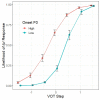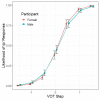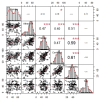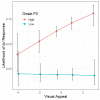Perceptual Cue Weighting Is Influenced by the Listener's Gender and Subjective Evaluations of the Speaker: The Case of English Stop Voicing
- PMID: 35529558
- PMCID: PMC9067435
- DOI: 10.3389/fpsyg.2022.840291
Perceptual Cue Weighting Is Influenced by the Listener's Gender and Subjective Evaluations of the Speaker: The Case of English Stop Voicing
Abstract
Speech categories are defined by multiple acoustic dimensions and their boundaries are generally fuzzy and ambiguous in part because listeners often give differential weighting to these cue dimensions during phonetic categorization. This study explored how a listener's perception of a speaker's socio-indexical and personality characteristics influences the listener's perceptual cue weighting. In a matched-guise study, three groups of listeners classified a series of gender-neutral /b/-/p/ continua that vary in VOT and F0 at the onset of the following vowel. Listeners were assigned to one of three prompt conditions (i.e., a visually male talker, a visually female talker, or audio-only) and rated the talker in terms of vocal (and facial, in the visual prompt conditions) gender prototypicality, attractiveness, friendliness, confidence, trustworthiness, and gayness. Male listeners and listeners who saw a male face showed less reliance on VOT compared to listeners in the other conditions. Listeners' visual evaluation of the talker also affected their weighting of VOT and onset F0 cues, although the effects of facial impressions differ depending on the gender of the listener. The results demonstrate that individual differences in perceptual cue weighting are modulated by the listener's gender and his/her subjective evaluation of the talker. These findings lend support for exemplar-based models of speech perception and production where socio-indexical features are encoded as a part of the episodic traces in the listeners' mental lexicon. This study also shed light on the relationship between individual variation in cue weighting and community-level sound change by demonstrating that VOT and onset F0 co-variation in North American English has acquired a certain degree of socio-indexical significance.
Keywords: English stop voicing; cue weighting; gender; paralinguistic information; personality traits; sociophonetics; speech perception; subjective evaluations.
Copyright © 2022 Yu.
Conflict of interest statement
The author declares that the research was conducted in the absence of any commercial or financial relationships that could be construed as a potential conflict of interest.
Figures








Similar articles
-
Cue-specific effects of categorization training on the relative weighting of acoustic cues to consonant voicing in English.J Acoust Soc Am. 2008 Aug;124(2):1234-51. doi: 10.1121/1.2945161. J Acoust Soc Am. 2008. PMID: 18681610 Free PMC article.
-
Perceptual Cue Weighting Matters in Real-Time Integration of Acoustic Information During Spoken Word Recognition.Cogn Sci. 2024 Dec;48(12):e70026. doi: 10.1111/cogs.70026. Cogn Sci. 2024. PMID: 39692598
-
Individual differences in perceptual adaptability of foreign sound categories.Atten Percept Psychophys. 2016 Jan;78(1):355-67. doi: 10.3758/s13414-015-0987-1. Atten Percept Psychophys. 2016. PMID: 26404530 Free PMC article.
-
Representation of speech variability.Wiley Interdiscip Rev Cogn Sci. 2017 Jul;8(4). doi: 10.1002/wcs.1434. Epub 2017 Feb 3. Wiley Interdiscip Rev Cogn Sci. 2017. PMID: 28160440 Review.
-
Phonetic cue weighting in perception and production.Wiley Interdiscip Rev Cogn Sci. 2020 Mar;11(2):e1521. doi: 10.1002/wcs.1521. Epub 2019 Oct 13. Wiley Interdiscip Rev Cogn Sci. 2020. PMID: 31608590 Review.
Cited by
-
Phonological discrimination and contrast detection in pupillometry.Front Psychol. 2023 Nov 1;14:1232262. doi: 10.3389/fpsyg.2023.1232262. eCollection 2023. Front Psychol. 2023. PMID: 38023001 Free PMC article.
-
Statistical learning across passive listening adjusts perceptual weights of speech input dimensions.Cognition. 2023 Sep;238:105473. doi: 10.1016/j.cognition.2023.105473. Epub 2023 May 19. Cognition. 2023. PMID: 37210878 Free PMC article.
-
How does the human brain process noisy speech in real life? Insights from the second-person neuroscience perspective.Cogn Neurodyn. 2024 Apr;18(2):371-382. doi: 10.1007/s11571-022-09924-w. Epub 2023 Jan 5. Cogn Neurodyn. 2024. PMID: 38699619 Free PMC article. Review.
-
Gender stereotypes and social perception of vocal confidence is mitigated by salience of socio-indexical cues to gender.Front Psychol. 2023 Dec 14;14:1125164. doi: 10.3389/fpsyg.2023.1125164. eCollection 2023. Front Psychol. 2023. PMID: 38155698 Free PMC article.
References
-
- Allison C., Auyeung B., Baron-Cohen S. (2012). Toward brief “Red Flags” for autism screening: The Short Autism Spectrum Quotient and the Short Quantitative Checklist for Autism in toddlers in 1,000 cases and 3,000 controls. J. Am. Acad. Child Adolesc. Psychiatry 51, P202–P212. 10.1037/t30469-000 - DOI - PubMed
-
- Babel M. (2012). Evidence for phonetic and social selectivity in spontaneous phonetic imitation. J. Phonet. 40, 177–189. 10.1016/j.wocn.2011.09.001 - DOI
-
- Babel M., McGuire G. (2013). Perceived vocal attractiveness across dialects is similar but not uniform, in Proceedings of Interspeech (Lyon: ).
LinkOut - more resources
Full Text Sources

